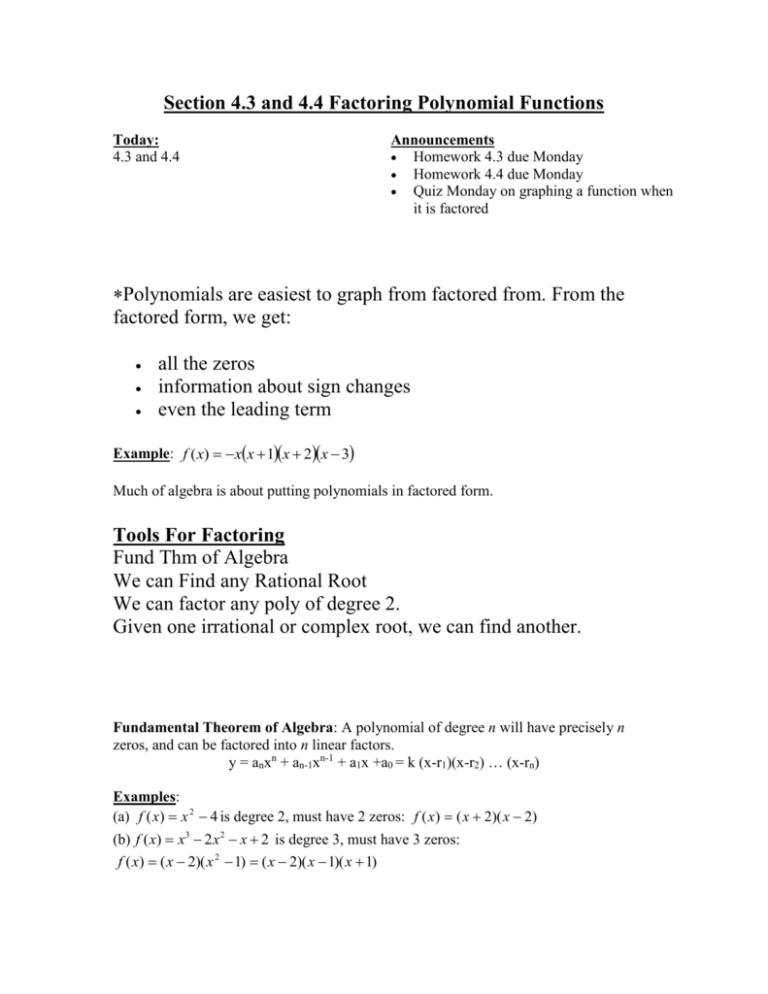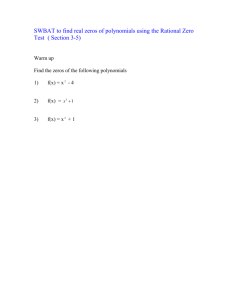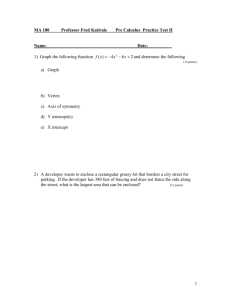MA112_F10_notes4pt4 - University of South Alabama
advertisement

Section 4.3 and 4.4 Factoring Polynomial Functions Today: 4.3 and 4.4 Announcements Homework 4.3 due Monday Homework 4.4 due Monday Quiz Monday on graphing a function when it is factored Polynomials are easiest to graph from factored from. From the factored form, we get: all the zeros information about sign changes even the leading term Example: f ( x) xx 1x 2x 3 Much of algebra is about putting polynomials in factored form. Tools For Factoring Fund Thm of Algebra We can Find any Rational Root We can factor any poly of degree 2. Given one irrational or complex root, we can find another. Fundamental Theorem of Algebra: A polynomial of degree n will have precisely n zeros, and can be factored into n linear factors. y = anxn + an-1xn-1 + a1x +a0 = k (x-r1)(x-r2) … (x-rn) Examples: (a) f ( x) x 2 4 is degree 2, must have 2 zeros: f ( x) ( x 2)( x 2) (b) f ( x) x3 2 x2 x 2 is degree 3, must have 3 zeros: f ( x) ( x 2)( x 2 1) ( x 2)( x 1)( x 1) Section 4.3 and 4.4 Factors and Zeros of Polynomials, and Finding Them There are three ways to think about the zeros of a function: way 1: a number x r1 is a zero if you plug it into the function and get zero: Example: x=2 is a zero of f ( x) x3 2 x2 x 2 because: f (2) 23 2 22 2 2 8 8 2 2 0 way 2: a number x r1 is a zero if it intersects the x-axis there Example: the graph of f ( x) x3 2 x2 x 2 shows that x=2 is a zero way 3: a number x r1 is a zero if x r1 factors into the function with no remainder Example: x=2 is a zero is of f ( x) x3 2 x2 x 2 because f ( x) ( x 2)( x 2 1) Check: f ( x) ( x 2)( x 2 1) x 3 x 2 x 2 2 x 3 2 x 2 x 2 Long Division of a Polynomal is like division of numbers, but easier. The factor Theorem If c is a zero of a polynomial P(x), then: P(c)=0 (x-c) is a factor of the polynomial P(x) (i.e., no remainder; R(x)=0) P(x)=(x-c)*Q(x) Example: P(x) = x2-4 =(x-2)(x+2) x=2 is a zero so P(2)=0: P(2) = 22-4 =0 (x-2) is a factor of the polynomial P(x) (i.e., no remainder; R(x)=0) long division shows that Q(x) = (x+2) P(x)=(x-2)*Q(x) = (x-2)*(x+2) Rational Zero Theorem In this section, we will learn how to find the zeros of a polynomial as long as they are rational. (finding non-rational roots for another section) The Rational Zero Test Suppose that P( x) a n x n a n 1 x n 1 a 2 x 2 a1 x a0 . Then any rational root of P(x) will be p / q where p divides the constant term a0 and q divides the leading coefficient an. Example: f ( x) x3 2 x2 x 2 has 3 zeros (x=2,1,-1). Show that these roots satisfy the rational zero test. a0 = 2, an = 1 x=2: 2 = p/q where p divides 2 and q divides 1 x=1: 1 = p/q where p divides 2 and q divides 1 x=-1: -1 = p/q where p divides 2 and q divides 1 (yes: p=2 and q=1) (yes: p=1 and q=1) (yes: p=-1 and q=1) Worksheet Determine all possibilities for rational zeros. f ( x) x 4 2 x 3 x 2 3 x 4 0 a0 = 4 an = 1 possible zeros are p/q where p divides 4 and q divides 1 p = numbers that divide 4 q = numbers that divide 1 all possible factors of 4 1,2,4 p = = = ±1, ±2, ±4 1 factors of 1 q Worksheet Determine all possibilities for rational zeros. f ( x) 6 x 5 24 x 4 40 x 3 48x 2 24 x 4 0 a0 = -4, an = 6 all possible zeros = all possible p/q = factors of 4 1,2,4 p = = factors of 6 1,2,3,6 q ±1/±1, ±1/±2, ±1/±3, ±1/±6, ±2/±1, ±2/±2, ±2/±3, ±2/±6, ±4/±1, ±4/±2, ±4/±3, ±4/±6 = ±1, ±1/2, ±1/3, ±1/6 ±2, ±2/3, ±4, ±4/3









